 Inevitably, another word needed to be explained is the name of the new car - there are several naming systems in Maranello, such as the engine capacity per cylinder (e.g. 250GT), the capacity plus no. of cylinder (246GT, 308GTB and 512TR etc.), the capacity plus no. of valves per cylinder (F355), the no. of years Anniversary (e.g. F40 and F50) and recently the engine capacity plus a geographic name. 550 Maranello and 360 Modena belong to the last type. While most people know Maranello, few know that Modena is the place where Ferrari, Maserati and Lamborghini located around thus gave it the reputation as the capital of sports cars. Styling and Aerodynamics
Pininfarina admitted the shape is more the work of wind tunnel job, where 5400 hours was spent during the development. Aerodynamists coming from the F1 team got rid of two of our favourite features : 1) the pop-up headlights; 2) a pair of flying buttresses and the flat engine lid separating them. The former is replaced by a pair of glass-covered headlights which are not only lighter but also drag free. On the contrary, the fastback rear window adds weight, but its benefit to aerodynamic drag and high speed stability is worthy. As in F40, the red-head engine and chassis frame can be seen through the huge screen. Engine breathing and cooling have separate intakes. Breathing is via those air scoops over the muscular rear arches, and they look as if inspired by the classic 250LM, Le Mans winner of 1965. Cooling takes place in the nose, behind a pair of huge blackholes. Having learned from Formula One, the radiators are positioned in a tilt angle against the wind thus reduce drag. Placing the radiator at the nose not only improve cooling efficiency (due to more undisturbed fresh air) but also contribute to the improved, 43 / 57 front to rear weight distribution. No wonder the new Porsche 911 did the same thing. Another reason to this change is to free up several extra inches behind the seats in order to make room for a golf bag, though Ferrari is less willing to admit. Aerodynamic revolution lies under the car - a longitudinal channel has been added to the originally flat carbon fibre undertray, drawing air towards the raised diffuser at the tail. Speak more clearly, this introduce ground effect thus greatly enhance high speed stability. At 180mph, there is 180kg of downforce, roughly 4 times of the F355. One source even said this is more than the huge-wing F50, believe or not ! Furthermore, the distribution of downforce matches exactly the front to rear weight distribution, thus contribute to a consistent handling irrespective to speed. The trade-off is quite modest - coefficient of drag increases from 0.32 to 0.335. Chassis and body If the styling and aerodynamics are deemed to be big changes, chassis and body are even more so. In dimensions, 360 Modena has grown a lot from F355, more than one can imagine. The length increases a massive 227mm, wheelbase jumps by 150mm to 2600mm which eclipses even 550 Maranello’s 2500. Height grows by 44mm to benefit head room. Oddly, the width has been reduced by 22mm to the still respectable 1922mm. Despite of the growth in wheelbase, larger proportion of the extra length has been spent to the overhangs in order to accommodate the radiators and diffuser, therefore to certain extent it seems not as radical as its predecessor. Overall speaking, the 360 is not only a replacement of the small Ferrari, but also fills the vacuum left by the mid-engined flagship Testarossa / 512TR / F512M.
360’s chassis is the combination of monocoque and spaceframe, both of which are made of aluminium alloy. The cabin section is monocoque (like F355), from which spaceframe mounted and extended to the front and rear. Most of the spaceframes are made by extrusion like the Elise, which requires the simplest tooling. However, unlike Elise but like Renault, individual frames are bonded together by welding instead of rivet and glue, quite conventional. The evidence of welding can be seen on the frame mounting the engine. The chassis is 27% lighter than F355’s steel one. Torsional rigidity has been increased by a massive 40%, thanks to the larger section of the frames. Although rectangular section seems less favourable than the original circular section in terms of stiffness, it provides flat surfaces for mounting the aluminium body panels, thus the latter can also contribute to the overall rigidity. As usual, the body panels are made by its long term partner Scaglietti (now fully owned by Ferrari). Having learned from F50, the rear suspensions’ wishbones and shock absorbers are partially mounted to the aluminium transmission casing. The latter is now mounted longitudinally behind the rear axle instead of transversely beneath the engine, this lower the V8’s center of gravity. The wishbones themselves are made of aluminium, which is an increasingly popular trend to improve ride quality as well as saving a few kilograms. Suspensions are double wishbones all round, but a vertical toe-control link is added to each of the rear suspensions. Six-setting adaptive damping is still there. All the weight saving works well to keep the car lighter than F355. Ferrari claimed the kerb weight 1390kg is some 100kg lighter than its predecessor, but as usual the official figures from Maranello are less reliable. My record book, again, tells me the F355 weighs 1422kg, therefore weight saving is just 32kg provided the figure for the new car is honest. Anyway, for a 400-horsepower supercar, it is still a super lightweight. Lightweight means better braking, however, Ferrari insisted to upgrade the brakes - 330mm discs all round actually exceeds 550M’s 330mm / 310mm, let alone F355’s 300/310. In addition to the four-piston Brembo callipers, stopping distance is roughly shortened by 10%. Wrapping around the discs are 215/45ZR18 front tyres and 275/40ZR18 rear rubbers, sandwiched between is the 18 inches magnesium wheels. Engine and Performance Thankfully, the heart and soul of F355 hasn’t changed much. The 40-valve V8 with titanium con-rod is further developed for the new car. It is not only as high-revving as ever, but low and mid range torque spread are also greatly improved. By adding 2mm stroke to the cylinders (now totally displaces at 3586c.c.), a Kevlar variable intake manifold and a phase-shifting variable valve timing to the exhaust valves (intake side is overcrowded), 20% more torque is accessible below 4,000rpm. Peak torque now occurs at 4750 instead of 6000, where an extra 7lbft is available. Maximum power increases 20hp to a full 400hp, and amazingly, this occurs at an even higher 8500rpm (compare to the previous 8250) !
Those criticised 550’s V12 as too quiet will be pleased by the Modena. To overcome the EU noise regulation, Ferrari’s clever engineers installed a tricky variable exhaust, which uses different length to generate different level of noise. It takes the advantage of the flaw in EU’s measurement method, switching the exhaust to the "loud" setting as soon as the measurement stopped. In terms of performance, 360 is marginally quicker than F355. Ferrari claimed the top speed is "more than 183mph", 0-100km/h (62mph) in 4.5sec, 0-400m in 12.6sec, 0-1km in 22.9sec. While all English magazines can just believe these figures, the Italian media has been given the first chance to test it against the clock. Quattroruote magazine took an F1 transmission car and timed 185mph top speed, 0-100km/h in 4.5sec, 0-160km/h (99.4mph) in 9.7sec. 0-400m in 12.7sec, 0-1km in 22.8sec, this confirmed Ferrari’s data. For your information, F355 F1 did 0-60mph in 4.7sec and 0-100mph in 10.8sec. Road test impression It’s a little bit disappointing to see the interior design. The upright facia makes no sense for an exotic mid-engined supercar. The modernised center console and dashboard cover with the most popular aluminium trim which you can find in any Audi TT. Luckily the traditional circular air ventilation holes are still there, and there are 5 of them. The extra dimensions boost more room in every direction, even behind the seats there is space for a full set of Golf clubs. (Enzo would have been disapproved this !!) Today Ferrari takes care of millionaires. At least the driving position is good and the seats are as superb as ever. The new 3-spoke steering wheel is far more stylish than F355’s, also feels nicer to handle as it is angled more towards vertical. The classical aluminium gear knob for the manual car remains in the familiar place, so is the paddles for the F1 shifter. Once fire the engine, all the unfavourable impression will be washed away. From 2700rpm, the engine note starts getting serious, so does the driver. The improved torque digs in, raising the rev quickly towards 5700rpm, where the second phase of the variable intake and the tricky variable exhaust triggers, then a surge of power, noise and rev comes.... Just a hesitation on the gear lever will bring the rev meter to the 8,800 rpm limit. The scream approaches the level of racing car. Not even the F355 delivered such experience. In terms of drivability, it would pull decently from 2,000 rpm. 3000rpm is more likely for F355.
The communication also comes from steering wheel. Thanks to the narrower front tyres (10mm reduction in width) as well as the quicker steering ratio ( lock-to-lock reduced from 3.2 to 3.0 turns), steering becomes sharper. On-lock feel is improved while kickback is reduced. The conclusion is
: Ferrari
has succeeded to replace the highly appreciated F355 with a car even
more
capable, more exciting yet more practical. This is a good news to those
millionaires as well as car dreamers like me, but could be a nightmare
to the forthcoming Porsche 996 turbo. |
| The above report was last updated on 4 May 99. All Rights Reserved. |
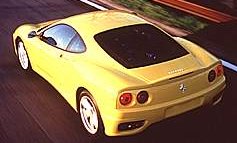 The
first sight of 360 Modena
gives mixed impression. Since the first Dino, every "mass production"
Ferrari
emphasised a low waist line (some call it "shoulder") which deliver a
feeling
of low center of gravity. In front of A-pillar the 360 is also quite
low,
but the waist line rise gradually towards the C-pillar, where a big
piece
of muscle tops the rear wheel. The waist line flat out towards the
little
tail spoiler. Therefore what you see is a wedge, or a car that looks
purely
a mid-engined Ferrari in the front but a muscular 550M at the rear.
The
first sight of 360 Modena
gives mixed impression. Since the first Dino, every "mass production"
Ferrari
emphasised a low waist line (some call it "shoulder") which deliver a
feeling
of low center of gravity. In front of A-pillar the 360 is also quite
low,
but the waist line rise gradually towards the C-pillar, where a big
piece
of muscle tops the rear wheel. The waist line flat out towards the
little
tail spoiler. Therefore what you see is a wedge, or a car that looks
purely
a mid-engined Ferrari in the front but a muscular 550M at the rear.
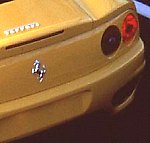 Most
magazines just briefly
described the Modena’s aluminium spaceframe chassis, even though they
know
it is the highlight of the technical aspect. So let us dig deeper …..
Record
book reminds me Honda NSX was the first car adopting aluminium chassis
in so-called mass production. Compare to the Japanese, Ferrari seemed
rather
reluctant to try new technology. Except the experimental 408GT of 1990
(an ugly concept car developed by Fiat rather than Ferrari), Maranello
always rely on traditional tubular steel spaceframe as their production
chassis. As time goes by, they found themselves lagging behind the
Lotus
Elise, Renault Sports Spider and even Audi A8 in chassis technology.
Sure,
they are leading in carbon fibre chassis, but cost and vibration
problem
prevent it from adopting to production cars. No wonder they ask the
American
aluminium giant Alcoa for help. If you still remember, Alcoa is the one
developing the ASF with Audi.
Most
magazines just briefly
described the Modena’s aluminium spaceframe chassis, even though they
know
it is the highlight of the technical aspect. So let us dig deeper …..
Record
book reminds me Honda NSX was the first car adopting aluminium chassis
in so-called mass production. Compare to the Japanese, Ferrari seemed
rather
reluctant to try new technology. Except the experimental 408GT of 1990
(an ugly concept car developed by Fiat rather than Ferrari), Maranello
always rely on traditional tubular steel spaceframe as their production
chassis. As time goes by, they found themselves lagging behind the
Lotus
Elise, Renault Sports Spider and even Audi A8 in chassis technology.
Sure,
they are leading in carbon fibre chassis, but cost and vibration
problem
prevent it from adopting to production cars. No wonder they ask the
American
aluminium giant Alcoa for help. If you still remember, Alcoa is the one
developing the ASF with Audi. 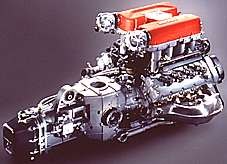 Another
important new item
is the individual, drive-by-wire throttle. Firstly, its lightning
action
sharpens the throttle response. Secondly, it works in concert with the
Bosch ASR traction control. Thirdly, it improves the downshift quality
of the F1 transmission. Click the downshift pedal, the electronic
throttle
will speed up the engine automatically, increasing the engine rev to
match
the new ratio thus guarantee a smoother transition. Within a few tenths
of a second, the computer does this precisely without nervous.
Otherwise
the F1 transmission’s hardware hasn’t changed, the same for the manual
box.
Another
important new item
is the individual, drive-by-wire throttle. Firstly, its lightning
action
sharpens the throttle response. Secondly, it works in concert with the
Bosch ASR traction control. Thirdly, it improves the downshift quality
of the F1 transmission. Click the downshift pedal, the electronic
throttle
will speed up the engine automatically, increasing the engine rev to
match
the new ratio thus guarantee a smoother transition. Within a few tenths
of a second, the computer does this precisely without nervous.
Otherwise
the F1 transmission’s hardware hasn’t changed, the same for the manual
box. 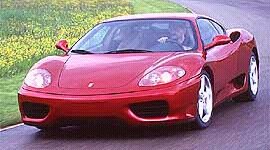 Enter
the first corner, the
360 demonstrates its superiority over F355 and virtually all other
greatest
cars in the world. It balances so well in the corners, making power
slide
an easy job. When you just thought you’ve entered too fast, the
downforce
still press the rear rubbers firmly on the road : Welcome to the world
of Ground Effect ! Go deeper, brake the super Brembo later, you
eventually
reach the limit of the car. Where a F355 will swap ends nervously,
Modena
will slide its rear end gradually and let you have the time to rescue -
back off the throttle and apply an opposite lock, the car tightens its
line without sweat. The chassis balances so well !
Enter
the first corner, the
360 demonstrates its superiority over F355 and virtually all other
greatest
cars in the world. It balances so well in the corners, making power
slide
an easy job. When you just thought you’ve entered too fast, the
downforce
still press the rear rubbers firmly on the road : Welcome to the world
of Ground Effect ! Go deeper, brake the super Brembo later, you
eventually
reach the limit of the car. Where a F355 will swap ends nervously,
Modena
will slide its rear end gradually and let you have the time to rescue -
back off the throttle and apply an opposite lock, the car tightens its
line without sweat. The chassis balances so well !
 Since the
debut of Mercedes SLK, I have not been interested in talking about
convertible
cars. You know, 99% such cars were derived directly from the hardtop
version,
with the roof chopped, added with a soft top and a hood cover, that’s
all.
Electric or not, how many seconds it takes to open / close the roof ...
these questions can hardly raise my interest. In my memory, only the
SLK’s
foldable hard top and Porsche 993 Targa’s sliding glass roof have
really
interesting innovations and worth a few hundreds of words to describe
them.
Since the
debut of Mercedes SLK, I have not been interested in talking about
convertible
cars. You know, 99% such cars were derived directly from the hardtop
version,
with the roof chopped, added with a soft top and a hood cover, that’s
all.
Electric or not, how many seconds it takes to open / close the roof ...
these questions can hardly raise my interest. In my memory, only the
SLK’s
foldable hard top and Porsche 993 Targa’s sliding glass roof have
really
interesting innovations and worth a few hundreds of words to describe
them.
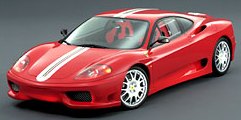 A couple
of months ago, I declared Porsche’s new 911 GT3 beating the Ferrari 360
as a driver’s car. That’s not a surprise, as we all know the GT3 is
designed
to be the most driver-focused model in the 911 range while the
4-year-old
Ferrari was originally designed to be a playboy supercar - to please
the
young millionaires with speed as well as look and quality. Now,
finally,
Ferrari decides to strike back with the first truly driver-focused 360,
the 360 Challenge Stradale.
A couple
of months ago, I declared Porsche’s new 911 GT3 beating the Ferrari 360
as a driver’s car. That’s not a surprise, as we all know the GT3 is
designed
to be the most driver-focused model in the 911 range while the
4-year-old
Ferrari was originally designed to be a playboy supercar - to please
the
young millionaires with speed as well as look and quality. Now,
finally,
Ferrari decides to strike back with the first truly driver-focused 360,
the 360 Challenge Stradale.
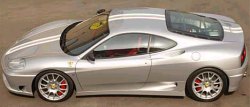 Thirdly,
the new Ferrari
has a set of super brakes - Brembo’s CCM carbon-ceramic brakes, like
that
used in the Enzo supercar. As you might know, the advantage of ceramic
disc is that it is highly resistant to heat, thus there won’t be any
fade
of braking power after the hardest use for all day. The Brembo brakes
enhance
stopping power by 15% yet saves 16% weight. It measures 380mm in front
brakes and 350mm at the rear, clamped by 6-piston and 4-piston aluminum
monobloc callipers respectively. Porsche GT3 also has ceramic brakes,
but
the Ferrari’s are bigger and needs to cope with less weight, thus you
can
easily see which one provide the strongest braking.
Thirdly,
the new Ferrari
has a set of super brakes - Brembo’s CCM carbon-ceramic brakes, like
that
used in the Enzo supercar. As you might know, the advantage of ceramic
disc is that it is highly resistant to heat, thus there won’t be any
fade
of braking power after the hardest use for all day. The Brembo brakes
enhance
stopping power by 15% yet saves 16% weight. It measures 380mm in front
brakes and 350mm at the rear, clamped by 6-piston and 4-piston aluminum
monobloc callipers respectively. Porsche GT3 also has ceramic brakes,
but
the Ferrari’s are bigger and needs to cope with less weight, thus you
can
easily see which one provide the strongest braking.
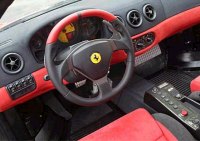 The worst
problem of the standard
Modena is that at the limit it becomes tail-happy. The new Stradale has
completely sorted out this problem, thanks largely to the new Pirelli P
Zero Corsa tires. These tires keep the rear end stick to the ground
and,
when they approach their limit, they let loose progressively thus the
driver
has plenty of time to adjust cornering attitude. As a result, the
Stradale
is easy to drive at the limit. You can turn it smoothly yet quickly
into
and out of corners, using throttle to correct its attack angle without
worrying the rear end suddenly break away. Put it this way, it corners
more like a Lotus Elise than a V8-powered supercar.
The worst
problem of the standard
Modena is that at the limit it becomes tail-happy. The new Stradale has
completely sorted out this problem, thanks largely to the new Pirelli P
Zero Corsa tires. These tires keep the rear end stick to the ground
and,
when they approach their limit, they let loose progressively thus the
driver
has plenty of time to adjust cornering attitude. As a result, the
Stradale
is easy to drive at the limit. You can turn it smoothly yet quickly
into
and out of corners, using throttle to correct its attack angle without
worrying the rear end suddenly break away. Put it this way, it corners
more like a Lotus Elise than a V8-powered supercar.